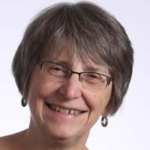Minnesota’s first university ESL program seeded programs throughout the state, building a web of caring human relationships that can help bridge linguistic and cultural differences. Dr. Elaine Tarone shares a description of how the program developed, and how, though moving through several institutional homes at the university, the program remained committed to sustaining that web.
A version of this paper, written by the recipient of MinneTESOL’s 2017 Harold B. Allen Award, was presented at the University of Minnesota on September 17, 2018, as part of the celebration of the ESL Program’s 50th anniversary. Readers interested in more detail on the history reported here can find it in Clements and Atterberry (2018), an online timeline with links to many archival documents.
In 1861, when the University of Minnesota was founded as a land grant institution, its mission focused exclusively on the practical needs of Minnesota residents, who spoke English as the language of government and education. There was no international vision; the U’s mission was intensely local. However, in 1945 after WWII, J. William Fulbright introduced a bill in the United States Congress that called for the use of surplus war property for an international purpose: “to bring a little more knowledge, a little more reason, and a little more compassion into world affairs and thereby to increase the chance that nations will learn at last to live in peace and friendship” (Fulbright, 2018).
U.S. colleges and universities began seriously recruiting ‘foreign students’ for this purpose. Such students, already highly educated in their own countries, and fluent in at least one language other than English, aimed to earn graduate and undergraduate degrees in the U.S., but were not necessarily fluent in English. Many required highly professional instruction in what came to be known as English as a second language, so the US government allocated resources to develop high quality ESL instruction in universities across the country.
As the number of ‘foreign students’ increased at the University of Minnesota during the 1950’s and 1960’s no regular course of ESL was provided to enable them to pursue high level academic work. Prof. Harold B. Allen, a linguist in the English Department and the first president of TESOL, was fully committed to this work; he sometimes taught noncredit ESL classes with a strong linguistic focus. He even brought in faculty from other departments to join him teaching occasional short-term intensive English language and cultural orientation programs, as when, for example, visiting faculty from Seoul National University came to the campus in 1956-7.
In 1968, Prof. Allen was instrumental in appointing Dr. Betty Wallace Robinett as Director of a new English as a Second Language (ESL) Program. The program had a 3-part mission: 1) to teach English to foreign students, 2) to prepare teachers of ESL, and 3) to do research on the learning and teaching of ESL. The teaching of English was carried out through two “Intensified” ESL programs: a noncredit English Program for International Students (EPIS) during the academic year, and a noncredit Summer Intensive English Language and Orientation Program (SIELOP). Though U.S. students were awarded credit for completing beginning levels of foreign language, international students were not awarded credit for completion of even the most advanced ESL courses, since (given the underlying assumptions detailed above) ESL was considered ‘remedial’. An MA program prepared ESL teachers to teach such students in college-level programs, and both faculty and graduate students conducted research projects on the learning and teaching of ESL.
Dr. Robinett was asked where she wanted to locate this tripartite ESL Program. Canestorp (2011) points out that there is considerable variation among U.S. universities in where ESL programs should be administratively placed. Some contention may be due to the misperception mentioned earlier that ESL instruction is ‘remedial’ rather than academic (Canestorp, 2011). At a land grant university, ESL program placement may also be contested due to the assumed scope of the land grant’s educational mission (local rather than global), the identity of the target student population (state residents rather than international citizens), and the language skills of that population (monolingual English rather than multilingual). Whatever the debate in 1968, at the University of Minnesota, the ESL Program was housed in the Linguistics Department in the College of Liberal Arts.
As a program director regularly meeting with Chairs and Directors with the CLA dean, Betty Robinett instilled very high standards for both ESL teaching and professional preparation for teachers. But in 1979 she went on leave from the department to become Associate Vice President of the University, a position she held until her retirement. Elaine Tarone (author) had just been hired to be the next in a series of tenure-track assistant professors with primary responsibility in the MA ESL program (for a list of these, see endnote 3). Upon arrival, she learned of the Director’s departure and was asked by Bruce Downing, chair of the Linguistics Department, to informally1 oversee all operations of the ESL Program, both the intensive English programs and the MA. Because she was untenured, she declined at first, and the chair assumed these duties; however, after a year she agreed. In 1980, the Minnesota English Center was formed, with Mark Landa as MEC director2, to house noncredit ESL classes for international students.
The Minnesota English Center
The MEC offered classes in the four skills (speaking, listening, reading and writing) and grammar (a ‘fifth skill’), for students testing in at four different proficiency levels. EPIS (academic year) courses and SIELOP (summer) courses were well articulated and students could move up to higher level classes in the different ‘skills’ in a highly individualized and seamless manner. An ethos of student-centered, highly individualized instruction aimed to meet students’ assessed communicative needs. Although Tarone periodically suggested that MEC courses be offered for credit (in parallel with all other foreign language courses at the U), MEC courses continued to be considered “remedial” noncredit courses.
In 1978, Mark Landa taught the first ESL course for international graduate TAs (ITAs) at the University. On June 6, 1983, a front-page story in the Star Tribune featured UMN students (two of whose parents were Minnesota legislators) saying they couldn’t understand their foreign TAs; the Minnesota legislature passed a funded requirement that ITAs improve their ‘foreign accents’. The ITA program was large enough by 1984 to need a coordinator, Jan Smith. With dedicated funding from the state, the ITA program grew to offer individualized training to all ITAs on campus. In 1995, Central Administration’s Office of Human Resources absorbed the program into its new Center for Teaching and Learning.
Other English courses for international students began to be introduced in a decentralized fashion outside the MEC as well: special sections of Freshman writing for international students in CLA, business English courses for international students in the Carlson School of Management; a summer course for international lawyers in the Law School. In 1989, General College approved a program for immigrant students called Commanding English (CE), originally directed by Susan Bosher and later by Robin Murie.
The M.A. in ESL
Betty Robinett’s high standards for teacher preparation had a lasting impact on the MA ESL program. From the beginning, the M.A. program required a semester each of introduction to linguistics, phonetics, research (initially on contrastive analysis but later second-language acquisition), ESL teaching methods, two semesters of English grammar, and two years of foreign language study. Students also had to write three research-based Plan B qualifying papers and pass a comprehensive oral exam, all within the span of two years. (Later required were a supervised and video recorded semester-long teaching practicum situated in the MEC, and a language assessment class.)
The MEC and the MA ESL were closely related. MEC instructors regularly mentored MA Practicum students in their classes in partnership with graduate faculty officially teaching Practicum. MA students who passed Practicum could be hired as MEC TAs, and upon graduation many were hired as MEC teachers, in a tight, supportive community with a shared investment in research-based pedagogical excellence. MA students often did the research for their Plan B qualifying papers in the MEC, gathering data from students there and proposing improvements to MEC pedagogy based on the outcomes of their research.
Over the decades, a succession of assistant professors3, some tenure-track and some not, were hired to teach graduate courses in the MA ESL program; supervise student teaching, research and writing of Plan B papers; and evaluate final oral exams. The quality of this work is evidenced by the fact that many graduates of the MA ESL program went on to publish their research in refereed journals or books. By 2006, at least 20 books and well over 170 scholarly papers had been published, many in top-ranked national journals4, by graduates of the MA ESL program. A partial list of these publications is available from the author upon request.
Graduate faculty in the M.A. program were able to guide MA students so effectively in their academic work because they themselves presented and published influential research in national venues. In consequence, the MA ESL program was for many years rated as among the top ten such programs in the nation. Graduates secured positions as leaders and teachers throughout the University of Minnesota, and in higher education throughout the state and the nation. MA ESL graduates also competed successfully for teaching and teacher training positions in such federal programs as Fulbright and the English Language Fellows (ELF) Program5.
Where to House the ESL Program?
Though the quality of the ESL Program (both the courses for international students and the teacher preparation degree programs) was maintained, the ‘90’s saw unfortunate changes in its institutional placement. In 1992, the Dean of the College of Liberal Arts abruptly closed Linguistics, the parent department of the ESL Program, and moved ESL into a newly formed Institute of Linguistics and Asian and Slavic Languages and Literatures (ILASLL). For 7 years, the ESL Program continued to function well there, but in 1999, the Asian languages program in ILASLL became an independent department. The remaining programs became the Institute of Linguistics, ESL and Slavic Languages and Literatures (ILES), a unit that institutionalized a growing separation between linguistics faculty and TESL faculty: At about this time, Klaeber Court was demolished, and ILES moved to Nolte Center. In 2003, as a result of advocacy by Lynne Ackerberg, MEC Director, the University approved a new Undergraduate Minor and Certificate in ESL as part of teacher preparation.
It is fair to say that, particularly after the ESL Program’s home department, Linguistics, was closed, and the Program’s ‘departmental home’ became less and less conventional, most Deans of the College of Liberal Arts (CLA) increasingly questioned its very existence in the College, citing budgetary constraints. CLA’s ambivalence may have been related to a more general questioning of the place of all the languages offered in CLA (Spanish, French, German). Whatever the reason, beginning in the 2000’s, CLA deans began the process of closing all ESL programs housed in the College of Liberal Arts – first the MEC, and then the ESL MA.
Late in the spring of 2004, the CLA Dean abruptly ordered the closure of the MEC. Six faculty and three administrators were laid off, and 19 noncredit ESL courses per semester were closed. International students could no longer be issued I-20 visas for English-only study at the MEC. However, because at the time of the Dean’s sudden announcement, some international students had already been issued I-20s for English-only study in the 2004 intensive summer ESL program, and some were already in transit, CLA was forced to reopen the MEC’s noncredit courses just for that summer. Because all but two teaching staff had already been laid off, MA ESL grad students taught those courses. By the beginning of Fall semester 2004, there was no longer any intensive noncredit ESL program at the University of Minnesota. Ironically, in 2004, the same year the MEC was closed, the University of Minnesota was ranked 21st in the nation in number of enrolled international students (Maupin, 2005).
In Fall 2004, 6 credit ESL classes (developed and proposed in haste during the summer of 2004) were offered by Lynne Ackerberg and Eric Nelson in ILES for matriculated students who had TOEFL scores below 213: advanced and academic classes in English grammar, pronunciation, reading and composition skills and oral skills. In 2005, these courses were transferred to the College of Continuing Education (CCE) (Canestorp 2011: 21), with Lynne Ackerberg as coordinator in both ILES and CCE between 2004-2007 effectively keeping English for international students alive in the gap between MEC and MELP.
The loss of the MEC as an intensive English program for non-matriculated students had an immediate negative effect on the University of Minnesota’s ability to recruit international students. International recruiters during the 2004-2005 year reported that the U lost desirable international students who needed an intensive English program. So two years after the MEC closed, in summer 2007, a new intensive English program, called the Minnesota English Language Program (MELP), was established in the College of Continuing Education (CCE). Mike Anderson was appointed Director in Fall 2007. Like the MEC, MELP offered a full intensive noncredit English language program (four proficiency levels, 5 ‘skills’) for non-matriculated students and issued I-20 visas to international students for English-only study at the U. MELP also offered the 6 credit ESL courses described above to matriculated students at the university.
Even though it was now housed in a different college (CCE), MELP assumed the role of providing graduate students in the MA ESL program with high quality practice teaching experiences, and hiring them as TAs. In July 2009, CLA deans moved the MA ESL and undergraduate ESL minor out of ILES, loosely affiliating them as the Program in Second Language Studies with the Department of Writing Studies. At that point, Tarone assumed the full-time Directorship of the Center for Advanced Research on Language Acquisition (CARLA); Professor Cohen began a 5-year process of phased retirement; and Professor Lazaraton became Director of Graduate Studies of the MA ESL program.
Soon after, in October 2011, the Dean of CLA completed the process, abruptly closing admissions to the MA ESL program. Alumni and friends, both in the University of Minnesota and in MinneTESOL, protested. During the next two years, no new students were admitted, existing MA ESL students worked on completing degree requirements, and a grievance filed by Professor Tarone was considered and rejected by CLA faculty committees. Negotiations to recreate the MA ESL in the College of Education and Human Development began, and in February 2013, an agreement was reached with faculty to recreate it in the Department of Curriculum & Instruction (C&I), along with the undergraduate ESL minor and certificate program. Even as students in the discontinued MA ESL program finished their degrees, new students were admitted to the MA in ESL for Higher Ed as a track in an existing M.A. in Second Languages and Cultures (SLC), with Professors Martha Bigelow and Kendall King as members of its graduate faculty. Later renamed the MA in TESOL (Teaching English to Speakers of Other Languages), the graduate program retains its close relationship with MELP in CCE. For example, MELP’s Director, Mike Anderson, teaches the MA TESOL Program’s Practicum course. Both the MA in TESOL and the undergraduate ESL minor and certificate programs have found faculty and student support in their new collegiate and departmental home.
Coda
 It is striking that something very important has happened at the University of Minnesota over the last fifty years (1968-2018) in spite of continuous change in formal administrative structures – founded in uncertainty about where to locate these ESL programs. That uncertainty is unsurprising given University infrastructure originally created for a monolingual, monocultural world. Something important happened when, at an informal level, a web of human relationships was created, endured and grew, a web in which there has been a shared commitment to the highest levels of quality of applied research and instruction in higher education. People whose careers began in the U’s ESL Program are now positioned as administrators and teachers throughout the University, across many units in many colleges. Now extending to colleges and universities throughout the state and nation, this web of human relationships still holds, united by what Lynne Ackerberg calls a “culture of appreciation” (Canestorp 2011: 20). This appreciation often transcends official academic roles as people pursue a commitment to a mission shared among teachers and teacher educators and researchers alike. That mission is to improve our understanding and practice of the learning and teaching of English, as a world language that can help bridge linguistic and cultural differences, in order to enable and improve world-wide access to knowledge and mutual understanding.
It is striking that something very important has happened at the University of Minnesota over the last fifty years (1968-2018) in spite of continuous change in formal administrative structures – founded in uncertainty about where to locate these ESL programs. That uncertainty is unsurprising given University infrastructure originally created for a monolingual, monocultural world. Something important happened when, at an informal level, a web of human relationships was created, endured and grew, a web in which there has been a shared commitment to the highest levels of quality of applied research and instruction in higher education. People whose careers began in the U’s ESL Program are now positioned as administrators and teachers throughout the University, across many units in many colleges. Now extending to colleges and universities throughout the state and nation, this web of human relationships still holds, united by what Lynne Ackerberg calls a “culture of appreciation” (Canestorp 2011: 20). This appreciation often transcends official academic roles as people pursue a commitment to a mission shared among teachers and teacher educators and researchers alike. That mission is to improve our understanding and practice of the learning and teaching of English, as a world language that can help bridge linguistic and cultural differences, in order to enable and improve world-wide access to knowledge and mutual understanding.
References
Canestorp, F. (2011). The growth of an emerging field: A history of ESL program development at the University of Minnesota. MA ESL, Plan B Paper, University of Minnesota. Available in the Digital Conservancy of the University of Minnesota: https://conservancy.umn.edu/handle/11299/164434
Clements, K., & Atterberry, D. (2018). Welcoming the world for more than 50 years: History of ESL at the University of Minnesota. Accessed 9-20-2018 at: https://cdn.knightlab.com/libs/timeline3/latest/embed/index.html?source=1unoMvwpomMfrslqPE3JK1YowOQo9txUn8ZlMQFYCy6k&font=Default&lang=en&initial_zoom=2&height=650
Fulbright (2018). http://www.fulbright.org.nz/about/ (Accessed September 2018).
Maupin, B. (2005). English as a Second Language programming for University of Minnesota international students: Present and future. MA ESL, Double Plan B Paper, University of Minnesota. Available in the Digital Conservancy of the University of Minnesota: https://conservancy.umn.edu/handle/11299/164638
Tarone, E. (2016). Minnesota’s multilingualism and English learner education: A historical perspective. MinneTESOL Journal, 32(2). http://minnetesoljournal.org/fall-2016/minnesotas-multilingualism-and-english-learner-education-a-historical-perspective
Notes
- After she left, no one was ever given Robinett’s position entitling her to participate in regular meetings of Chairs and Directors with the dean of CLA. In retrospect, that was a mistake, since it meant deans and chairs knew very little about what the program did.
- The Directors of the Minnesota English Center (MEC) were Mark Landa (1980-1995), Lynne Ackerberg (1995-2002) and Bill Hellriegel (2002-2004). Prior to his MEC Directorship, Landa directed the English Program for International Students (EPIS) (1975-1980); Betty Robinett personally directed EPIS before that, 1968-1975.
- A succession of professors was given primary responsibility for graduate coursework and requirements for the M.A. in ESL, 1968-2011: B. W. Robinett, Amy Sheldon, Ralph Nash, Jean Peterson, Dennis Godfrey, Elaine Tarone, George Yule, Andrew Cohen, Bill Johnston, Anne Lazaraton, Mike Anderson, Doug Margolis. Some but not all were appointed as tenure-track; only some tenure-track professors were granted tenure.
- In addition, it was a group of MA ESL students who founded MinneTESOL as a professional association (Tarone, 2016), and MA ESL graduates who founded the MinneTESOL Journal, often serving as editors as well.
- MA ESL graduates have secured positions ranging from dean to teacher to researcher in a range of contexts in higher education:Within the University of Minnesota
-
- In Human Resources: Teaching & Learning, ITA program
-
- In CLA: Writing Studies, Writing Center, Language Center, Spanish, Italian, Speech-Language-Hearing
-
- In CEHD: C&I ESL minor, NCEO, OLPD, College English Transitions, Family Social Science
-
- In CCE: MEC program admin & teaching
- In Nursing: instructional design
In other Minnesota colleges and universities- MNSCU Faculty Development, Hamline University, Luther Seminary, UMN Morris, Minneapolis College, Century College, St Paul College, N. Hennepin Community College
In universities & institutions outside Minnesota:- Georgetown University, Teachers College Columbia University, Michigan State, University of Georgia, Texas A&M, UNC Wilmington, UC San Diego, University of Wisconsin (Madison, Eau Claire, River Falls, Oshkosh), Portland State, Cal State Monterey Bay, Massachusetts International Academy, Nagoya University, Dokkyo University, Tsuda University, Hosei University, Educational Testing Service, Szeged University Hungary, Hope Academy of Biskek in Kyrgystan
-








